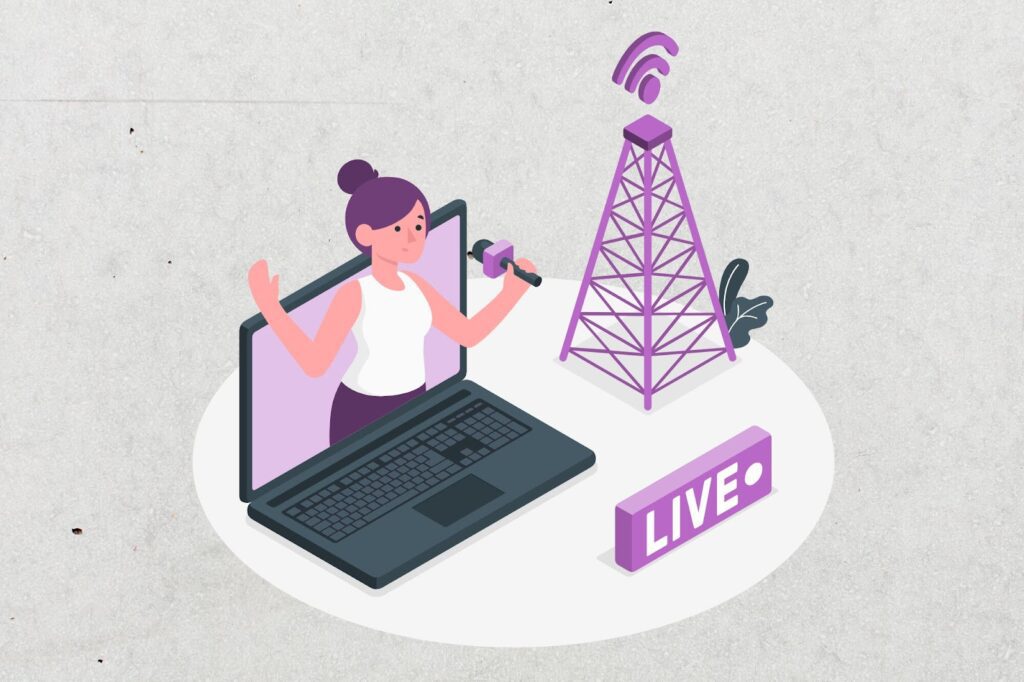






Quick Overview
Social media refers to online platforms that allow people to create, share, and interact with content in real time. In the context of news and sports, it has transformed how information is reported, consumed, and discussed. This blog will walk you through:
✅ Real-time reporting and live updates on platforms like Twitter, Facebook, and Instagram
✅ Enhanced fan engagement through behind-the-scenes content and interactive features
✅ Democratisation of information via citizen journalism and influencer contributions
✅ Challenges such as misinformation, privacy concerns, and maintaining journalistic integrity
✅ Future trends involving AI, VR/AR, and evolving audience preferences for short-form content
Those who focus on reporting the news with integrity will be best prepared for the future of social media as a news and sports reporting source. Social media has grown in importance in our lives due to its widespread use. There are a number of platforms, such as Facebook, Twitter, and Instagram, that are pivotal to our daily lives. This essay will discuss how social media has changed the way we share, receive, and report news and sports. The influence of social media cannot be underestimated, as it has drastically changed the way we report news and sports.
First of all, the growth of Facebook, Twitter, and Instagram has changed the way we report news. Nowadays, people rely heavily on Facebook and Twitter to get their daily news, but this doesn't guarantee that the news they get is factual.
In conclusion, the growth of social media has significantly changed the way we share, receive and report news and sports. The impact of social media cannot be underestimated, as many people use social media platforms to share their opinions and thoughts.
When news was new, the mainstays of news reporting were print, radio and television – newspapers and magazines, journalists and correspondents, radio and television programmes, and broadcasting by radio and television on set schedules. In this context, news was delivered on a fairly delayed basis, with content and timing dictated by printing deadlines and broadcasting schedules. Therefore, the journalists and correspondents were considered the 'gatekeepers' of the news and the 'veil' that separated the public from the 'information stream'.
Other aspects of sports reporting also took a turn for the digital. With the evolution of the internet, news outlets and blogs popped up all over the web, offering a more flexible and quicker way of updating information, while the switch to digital allowed news and updates to become available 24 hours a day, seven days a week. Changes also occurred in the way in which stories developed. Unlike in the print era, when a story needed to be completed before it went to press, in the digital world, editors could update a story throughout the day, or as often as they desired, and then send it out to subscribers. This meant that stories no longer had to be packaged but could instead evolve as they unfolded in near real-time.
As access to the internet became more widely available, news could now be distributed free from the overhead costs associated with print or broadcast media, thus rendering print media obsolete. With the proliferation of online news outlets and an easy way to reach news consumers, more and more readers have made a switch to their devices for the latest information.

News and sports updates on Facebook, Twitter, Instagram, YouTube and TikTok all share the same base, but they have their unique places. The huge number of users on Facebook makes it a great place to spread articles and live updates, with many outlets sharing their live feeds of all kinds of stories. Its 280-character limit makes Twitter a great place to share short updates in real-time, which is why you will often find breaking news or live sports commentary or updates on Twitter first, in very short snippets. Instagram and TikTok's focus on images makes them great for sharing backstage clips, highlights and quick updates. YouTube's video focus means that it's a great place for analysis, interviews and longer-form content.
First, social media can bring the readers and viewers speed and immediacy that was traditionally available only through eyewitness accounts. Stories can be shared immediately as they occur, giving up-to-date information to audiences as soon as it is verified. This is especially important in sports reporting, where live updates and play-by-play commentary are vital. We see it all the time when a major news story or live sports update is first published on social media before appearing anywhere else. The speed at which news spreads now is a modern expectation of all audiences, and real-time reporting has become the norm rather than the exception.
Social media, in a similar way, has not only decentralised the means of production. It has also allowed anyone with an internet connection access to the means of information dissemination. News can break from any person, anywhere, and at any time, a phenomenon that has been variously referred to as 'the end of professionalism' or 'participatory journalism' – or simply 'citizen journalism'. This has the advantage of increasing the volume and diversity of news sources. But it also increases the challenge of verifying what's being reported. At the same time, social media has proven a vital resource for real-time updates from eyewitnesses and on-the-ground reporters and otherwise unfiltered, raw insights into events as they unfold.

In the age of social media, journalists are under more pressure than ever to report quickly. The news cycle of the past, measured in hours or days, is now measured in minutes or seconds. This pace is made possible by the global reach of social media, which can broadcast news to a worldwide audience in real-time. This means that journalists have to work at achieving the perfect balance between speed and accuracy: they can be reporting news as it happens and checking their facts all at the same time.
Social media has changed the relationship between audiences and news. Facebook and Twitter help us 'like', 'share' and comment on a news story, creating a two-way interaction that turns news into a conversation. Journalists can also talk to their readers – whether it's a poll, Q&A session or live chat. The sense of sharing creates a feeling of community and can even help create a loyal readership. It also allows journalists to get feedback on what makes a story appealing and new ideas for future stories. News stories can also be shaped by public opinion.
While there are many benefits to social media as a tool for news reporting, it introduces many risks as well. The rapid dissemination of information allows fake news and misinformation to go viral. The problem of rapid dissemination of news can be countered only by rigorous fact-checking and verification processes that have been well-tried over the years to maintain journalistic integrity.
News reporting has always been a balancing act between being a first-mover, which entitles the news outlet to the first-mover advantage and being correct. Now, the stakes are higher. The reporting of fake news can seriously damage a news organisation's reputation, and the consequences of spreading false information can be serious. The rise of social media has added another layer of complexity to an already difficult profession. For this reason, fact-checkers and editors are more important than ever.
Social media has dramatically changed the way that sports are reported. Gone are the days when fans had to wait for a newspaper the next morning to get an update on an exciting game. Now, fans can receive updates in real-time through Twitter or Facebook, allowing them to follow along with the action even if they are unable to watch a game live. Though Twitter and other social media are most commonly associated with live tweeting events, many sports journalists tweet play-by-play commentary during live sporting events. Both journalists and fans alike upload images and videos through these social media channels, which may include highlights of exciting plays or behind-the-scenes content. This immediacy allows fans to feel as though they are experiencing the event right alongside the players and other fans.

Furthermore, live streaming on YouTube, Instagram, and other sites allows fans to watch games in real-time and, at times, from different angles, which further improves the experience by making it more interactive and immersive. A fan can tune in to almost any game, big or small, on multiple different devices at once through social media.
Arguably, the most significant change to the sports-fan relationship is the direct communication that social media enables between the two. With Twitter and Instagram, athletes are able to communicate on a regular basis with hundreds of thousands of followers, offering them insight and updates from their training and private lives and taking them on their private journeys behind the camera. This direct communication leads to a more personal connection between fans and athletes. It makes them truly feel like they share something special.
Social media plays a major role here, too. Facebook pages run by teams, Facebook groups run by fans, or even fan groups on Reddit all serve as places for fans to discuss games, share content, and connect with each other. This adds to the sense of community that surrounds all sports fans, making them feel part of something greater than they are.
Social media grants fans access to their lives in an entirely new way. Instagram and YouTube have given athletes the means to share their lives in ways previously unavailable to their fans. Short segments on Instagram or YouTube, called 'Stories' and vlogs, respectively, are more laid-back and intimate than typical video highlights, commercials or player profiles. They allow for a greater variety in subject matter. An inside look at workouts, pre-game routines, and off-season hobbies – all are part of an athlete's life that they might allow fans to see.
This insider content makes athletes more relatable, helping fans better understand the work, passion, and personality that go into the public personas. It also gives fans an unfiltered look into the world of sports that transcends games and scores, deepening their involvement.

As an example, social media influencers have grown to enormous popularity, where they can shape public opinion in news and sports. Influencers, with their millions of fans and constant attention, can influence public opinion and dictate trends. In sports, influencers use their large followings and reach to collaborate with athletes and brands to produce content that reaches a mass audience and intertwines the old world of sports reporting with the new world of digital marketing.
As traditional media outlets start working with influencers, they're able to drive traffic to their sites and their content by blending the reach of the influencer with the vigour and credibility of traditional media. In some cases, influencers can provide a younger, more connected voice that can attract a younger audience, while the traditional media outlet is then able to provide the rigour and structure that can upgrade the quality and credibility of the material that the influencer is producing.
A robust social media presence has become an unquestioned part of the athlete's brand-building strategy. The personal website, Twitter and Instagram accounts, and the articles written in an athlete's voice all help to develop and promote a cheerfully individualistic online personality. Likewise, journalists and editors are encouraged to cultivate their own social media presence. Twitter, Instagram, and especially LinkedIn offer a means for them to connect and network with colleagues. Journalists are encouraged to share and promote their work, build a following around their 'personal brand', and maintain their presence in the media landscape. The athlete-journalist relationship, then, is one of the myths that athletic capitalism is built upon. It is a story that invites the athlete and the journalist to participate in the same culture of cheerfully individualistic self-promotion that defines the athlete's brand.

While journalists might use social media to share their work, engage with their audience or build a personal brand, personal brands can be found anywhere and everywhere. The success of personal brands such as LeBron James, Adrian Wojnarowski and others shows that purposeful personal branding can improve your career and sway others' thinking in your favour.
The biggest challenge to maintaining journalistic standards in social media reporting is the speed of reporting on social media. The need to be first often outweighs the importance of getting it right. Journalists need to walk a tightrope between being fast and being right so that the information that is reported is correct. The ethical use of social media reporting is an area that demands high standards so that truth and reliability are not sacrificed for sensationalism.
The pervasiveness of social media also raises privacy issues. Privacy is vital, especially in vulnerable situations. When journalists and influencers have access to personal and private information, they must respect this privacy and not publish anything that would harm the individual. Ensuring privacy is integral to ethical reporting.
Sponsored content on social media has been a lucrative way to bring in extra revenue, but it can also tarnish a journalist or brand's reputation if not clearly disclosed or if it starts to make up the majority of their content. Journalists and influencers alike would do well to make their sponsored posts clear and ensure that their paid partnerships don't outnumber their more organic coverage. This way, they will maintain the trust of their audience.

In this regard, new technologies such as AI and machine learning can be game-changers for social media reporting. AI can help analyse data in real time, produce content, and deliver news based on users' individual preferences. Meanwhile, virtual reality (VR) and augmented reality (AR) can soon offer fans new experiences in which they can feel closer to the action than ever before.
Audiences' desires are always changing – and they're changing even faster these days. They're increasingly favouring video content and other short-form media, such as the popular TikTok and Instagram Reels. News and sports reporters now have to adapt to audiences' changing consumption habits to create content that grabs attention quickly and passes on information efficiently.
Social media is always changing, so new ways to use these platforms should evolve to keep news and sports reporters current with their audience and allow them to reach new audiences. The future of how people report news and sports on social media will be more interactive and interconnected with AI. The way that content is delivered will continue to change and evolve. Those who embrace these changes while focusing on reporting the news with integrity will be best prepared for the future of social media as a news and sports reporting source.
Social media has drastically changed the way news and sports are reported. It provides instant updates, two-way conversations and unprecedented access to athletes and events. While it brings a lot of benefits, such as interaction and democratisation of information, it also has its pitfalls. These include the proliferation of fake news and the invasion of privacy. While social media is here to stay, we need to take advantage of its benefits while keeping an eye out for its pitfalls. Reporting in the digital age is constantly adapting to new technologies and trends. This will continue to be the case in the future of reporting in the digital age.